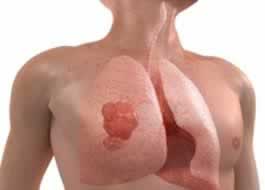Acute side effects
Damage to the epithelial surfaces. Epithelial surfaces may sustain damage from radiation therapy. Depending on the area being treated, this may include the skin, oral mucosa, pharyngeal, bowel mucosa and ureter. The rates of onset of damage and recovery from it depend upon the turnover rate of epithelial cells. Typically the skin starts to become pink and sore several weeks into treatment. The reaction may become more severe during the treatment and for up to about one week following the end of radiotherapy, and the skin may break down. Although this moist desquamation is uncomfortable, recovery is usually quick. Skin reactions tend to be worse in areas where there are natural folds in the skin, such as underneath the female breast, behind the ear, and in the groin.
If the head and neck area is treated, temporary soreness and ulceration commonly occur in the mouth and throat.[18] If severe, this can affect swallowing, and the patient may need painkillers and nutritional support/food supplements. The esophagus can also become sore if it is treated directly, or if, as commonly occurs, it receives a dose of collateral radiation during treatment of lung cancer.
The lower bowel may be treated directly with radiation (treatment of rectal or anal cancer) or be exposed by radiotherapy to other pelvic structures (prostate, bladder, female genital tract). Typical symptoms are soreness, diarrhoea, and nausea.
Swelling (edema or oedema). As part of the general inflammation that occurs, swelling of soft tissues may cause problems during radiotherapy. This is a concern during treatment of brain tumours and brain metastases, especially where there is pre-existing raised intracranial pressure or where the tumour is causing near-total obstruction of a lumen (e.g., trachea or main bronchus). Surgical intervention may be considered prior to treatment with radiation. If surgery is deemed unnecessary or inappropriate, the patient may receive steroids during radiotherapy to reduce swelling.
Infertility. The gonads (ovaries and testicles) are very sensitive to radiation. They may be unable to produce gametes following direct exposure to most normal treatment doses of radiation. Treatment planning for all body sites is designed to minimize, if not completely exclude dose to the gonads if they are not the primary area of treatment.
Medium and long-term side effects
These depend on the tissue that received the treatment; they may be minimal.
Fibrosis
Tissues which have been irradiated tend to become less elastic over time due to a diffuse scarring process.
Hair loss
This may be most pronounced in patients who have received radiotherapy to the brain. Unlike the hair loss seen with chemotherapy, radiation-induced hair loss is more likely to be permanent, but is also more likely to be limited to the area treated by the radiation.
Dryness
The salivary glands and tear glands have a radiation tolerance of about 30 Gy in 2 Gy fractions, a dose which is exceeded by most radical head and neck cancer treatments. Dry mouth (xerostomia) and dry eyes (xerophthalmia) can become irritating long-term problems and severely reduce the patient’s quality of life. Similarly, sweat glands in treated skin (such as the armpit) tend to stop working, and the naturally moist vaginal mucosa is often dry following pelvic irradiation.
Fatigue
Fatigue is among the most common symptoms of radiation therapy, and can last from a few months to a few years, depending on the quantity of the treatment and cancer type. Lack of energy, reduced activity and overtired feelings are common symptoms.
Cognitive decline
In cases of radiation applied to the head radiation therapy can cause cognitive decline
Cancer
Radiation is a potential cause of cancer, and secondary malignancies are seen in a very small minority of patients, generally many years after they have received a course of radiation treatment. In the vast majority of cases, this risk is greatly outweighed by the reduction in risk conferred by treating the primary cancer.
Death
Radiation has potentially excess risk of death from heart disease seen after some past breast cancer RT regimens.





